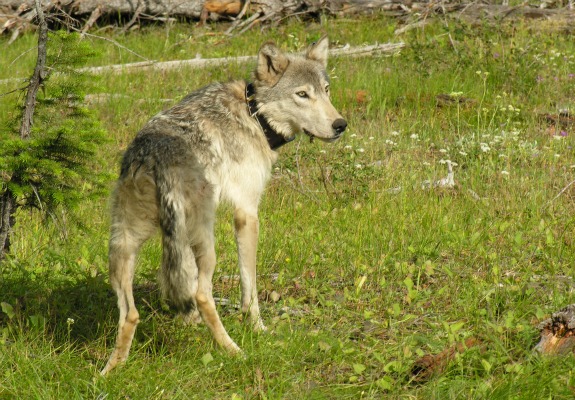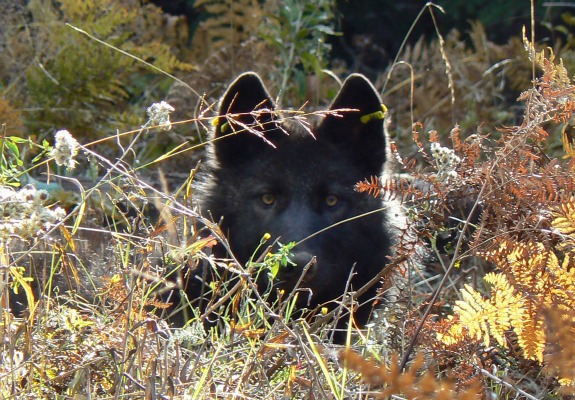Wolves Are Returning to Oregon–but Not All Locals Want Them
In 1947, the last wolf in Oregon was killed for a bounty fee of $5 just outside of Crater Lake National Park. Now, the animals are staging a comeback
An Oregon wolf looks straight into the lens of a photographer. The animals have returned to eastern Oregon and are spreading through the state. Photo courtesy of Oregon Department of Fish and Wildlife.
In 1947, the last wolf in Oregon was shot and killed for a bounty fee of $5 in the wilderness near Crater Lake.
Now, after more than 50 years of absence, the animals are staging a comeback. They have established themselves in the eastern quarters of the state and are subsisting on local elk and deer herds–and, as might be expected, the occasional cow and sheep. Also quite predictably, the return to Oregon of one of the world’s most maligned and persecuted predators has Oregonians passionately polarized on the matter, with many people fully in support and others adamantly opposed to the animals’ reappearance. Livestock ranchers have led the campaign to stop the return, which is occurring naturally–although only as a result of the 1995 reintroduction of Canadian gray wolves to the Yellowstone National Park region, in Wyoming, Montana and Idaho. Those animals have thrived and flourished, and experts expect that the same could happen in Oregon.
The first wolf to return to Oregon in modern times entered the state from Idaho in 1999. The animal, known as B-45F to researchers, was trapped and sent home to Idaho by wildlife officials, however. Subsequently, two other wolves were hit and killed by cars in Oregon, and one was shot by a poacher, according to Sean Stevens, executive director of the wildlife and natural space advocacy group Oregon Wild, who recently spoke with me by telephone. But in 2007, an animal wearing a remote tracking collar and named B-300 by researchers, who had tranquilized and handled it in Idaho, entered Oregon. Here, it put down roots, and in the summer of 2009, officials with the Oregon Department of Fish and Wildlife confirmed the presence of three adult wolves and three pups in Wallowa County–the first wolf pack in Oregon in about six decades.

Wolf “B300″ was the first to enter Oregon ans remain there. The wolf would form a pack and has since produced multiple pups. Photo courtesy of Oregon Department of Fish and Wildlife.
Now, at least 30 wolves in five packs live in Oregon, according to Michelle Dennehy, communications officer with the Oregon Department of Fish and Wildlife.
“We want confirmation of two pups for an adult pair before we consider it a pack breeding pair,” she said. “By now, all five packs have produced multiple pups.”
Dennehy says that the Department of Fish and Wildlife has confirmed 54 head of Oregon livestock killed by wolves as of July, with most kills being cattle, a few sheep and one a goat. Several wolves have been legally killed, she said, as a result of habitual depredations on livestock, and Dennehy says that the state of Oregon, along with Defenders of Wildlife, have joined resources to reimburse farmers who have suffered losses. The state’s Department of Agriculture has allocated a reimbursement fund, too.
Even before the first modern-times wolf moved permanently into Oregon, officials foresaw the potential for the species’ return and the problems the wolves might cause. And so the Oregon Wolf Conservation and Management Plan was enacted in 2005 by the state of Oregon with the intention of readying the state and its people for the presence once again of the gray wolf. The wolf plan outlines just how to respond to wolves that prey upon livestock and at what point Oregon wolves might be removed from the state’s endangered species list as their numbers grow, among other issues of question. Ranchers, hunters, hikers, conservationists, government land managers and other stakeholders took part in developing the wolf plan, Dennehy said.
According to Stevens at Oregon Wild, roughly 1,000 wolves could probably live in Oregon’s vast wild spaces, mostly in the arid eastern half of the state. Ranchers of cows and sheep are hardly thrilled at the idea, however. They have already helped write and introduce multiple legislative efforts to block the wolves’ return–one a proposal that, had it become law, would have allowed a person to shoot a wolf onsite if he or she deemed the animal to be a threat.
It would have also done something else controversial. “It would have taken the management of an endangered species out of the hands of government and given it to private citizens,” Stevens said.
It was the Oregon Cattlemen’s Association that introduced that proposed law. This year, the same group introduced another effort to rid the state of wolves–a piece of legislation calling for a state of emergency in eastern Oregon because of the wolves’ presence. Both proposals were rejected by lawmakers.
More than 1 million cows live in the state, according to Stevens. In 2010, he says, 55,000 of those cows died prior to entering the slaughterhouse of disease, nasty weather and other non-wolf causes.
But Rod Childers, the Oregon Cattlemen’s Association’s Wolf Committee Chairman, says that ranchers are suffering far greater financial losses because of wolves than have been conveyed to most media. Childers, who raises cattle in Wallowa County, says that for every dead cow or sheep confirmed as a victim of wolves, several more wolf kills go unconfirmed, due either to inconclusive evidence or the entire lack of a carcass. That is, some animals simply go missing–and they’re doing so at about double the rate that they once did. Childers says he is certain that the wolves are involved.
“Because nothing’s changed but the wolves,” he explained. “We’ve always had cougars, bears, coyotes. But now wolves are here, and our losses are up.”
Childers says that in Wallowa County, 26 head of cattle have been confirmed as killed by wolves. But 86 other animals have disappeared–almost certainly, he says, killed by wolves.
And the reimbursement plan is not a fair deal, Childers says, because it only provides payment for confirmed wolf depredations. Childers also points out a more subtle loss that he and other ranchers are enduring: Their animals have been returning from their high country summer pastures thinner than they once did–a result, he explains, of being continually harassed and attacked by wolves. Such underweight animals bring ranchers less profits than properly fattened cows might.
“But that’s not accounted for in the wolf plan,” he says.
While tempers flare and the occasional bullet flies at a wolf, the biggest wild canine is still expanding its range. Now, as officials and others expect continued growth in the wolf population, another question arises: How far will the wolf go? In fact, one wolf, a collared animal named OR-7, became the first wolf to go west of the Cascades since the bounty days—and eventually entered California. The animal has been nicknamed “Journey,” and the California Department of Fish and Game is tracking and publicizing the animal’s approximate whereabouts via the Internet.
The wolf situation in Oregon is extraordinary because the animals are coming back on their own–a rare example of a large predator actually expanding its range instead of, as is the more common pattern, diminishing ever closer to extinction. Moreover, the fact that their swelling population has spilled into Oregon’s more vacant regions indicates that, aside from a few conflicts with livestock, there may be room for the animals.
Today, wolf tourism could be a new draw for visitors to wolf country. Oregon Wild has led tours to eastern Oregon each of the past three years to show groups of about 10 people the state’s wolf habitat—and to meet the ranchers who believe their livelihoods may be imperiled by the animals. Check the organization’s website to learn more.
Size matters. Some wolf opponents are arguing that the wolves now recolonizing Oregon are larger than those wiped out last century. If true, this would be more than just interesting. It would also mean that the animals need more food and are more capable of taking down large head of livestock. While it may be true that the wolves of Oregon today are of different genetic roots than those that inhabited the state in the past, scientists and experts have denied that they are substantially larger.
What do you think? If wolves want back in to Oregon and California, should we welcome them?
Planning Your Next Trip?
Explore great travel deals
Smithsonian magazine participates in affiliate link advertising programs. If you purchase an item through these links, we receive a commission.
/https://tf-cmsv2-smithsonianmag-media.s3.amazonaws.com/accounts/headshot/Off-Road-alastair-bland-240.jpg)

/https://tf-cmsv2-smithsonianmag-media.s3.amazonaws.com/accounts/headshot/Off-Road-alastair-bland-240.jpg)